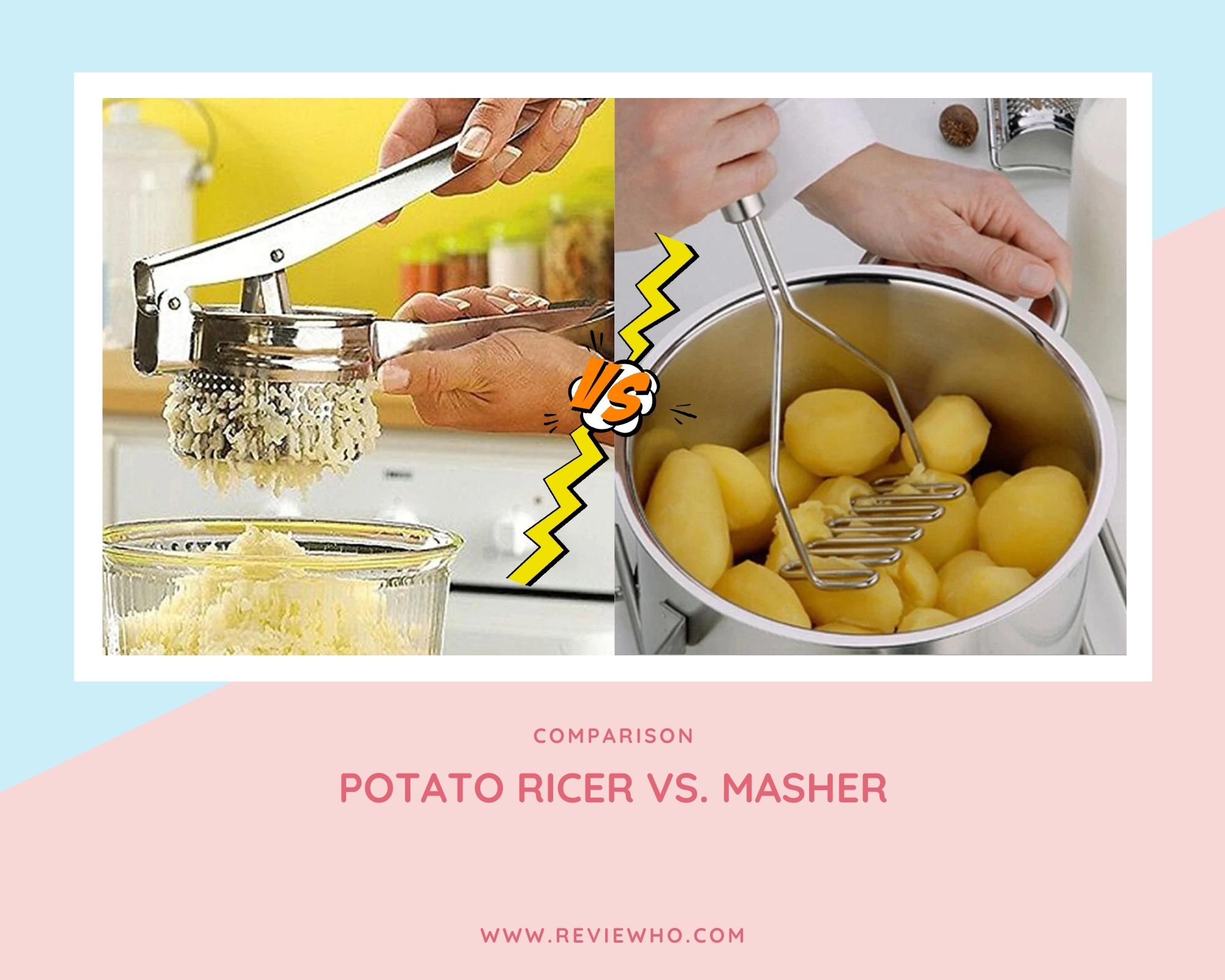Potatoes are common ingredients in very many recipes. You can use potatoes in different ways in your recipe. Mashing potatoes is one of these ways, which is why we need potato mashers in our kitchens.
Have you used a potato masher or ricer before? Do you know the difference between these two?
Potato mashers and ricers are debated widely as kitchen utensils. They might have some similarities but there are certain differences.
What is the main difference between a ricer and a masher? Do I need a potato ricer or masher for my ingredient preparation?
This article highlights all the potato ricer vs. masher differences and similarities. We will help you identify the utensil that you need for your meal preparation. Read on for more insight!
Potato Masher

Potato mashers are not fully appreciated, mainly because people think that they tend to leave lumps when used. The truth though, is that you can get creamy, smooth potatoes when you use a masher. The only thing you would have to do is to use the proper method when mashing your potatoes.
That involves getting to every inch of that pot and pressing and twisting when mashing. At some point, you might need to add some liquid to help make things smoother.
Remember, your potatoes need to be cooked properly.
If you appreciate potato skins in your finished meal, maybe for some texture or nutrition, then you would need a metal spoon or a masher.
You should not expect a masher to give you a fluffy, light result.
Potato mashers are mainly made using stainless steel and are widely available in different styles that help cut through different foods, including potatoes with ease.
Potato Ricer

Potato ricers, as you would expect from the name, force your cooked potato through some small holes which result in potatoes that look like rice, which is the reason for the name.
You can identify a potato ricer easily. It features a hopper where the potatoes go. They do not have to be peeled by they should be cooked. The ricer also has a plunger that will press the potato, forcing it through those holes.
When the potato is being pressed using a ricer, air will be incorporated into the potato, which results in light potatoes.
A ricer will not give any lumps in the resulting food. What’s more, they will be smooth and you can be sure that you will enjoy them. The only problem associated with ricers is that you can take a bit more time to prepare your potatoes, especially if they are not peeled. If you are pressing unpeeled potatoes, you will have to keep removing the skins from the ricer or the holes will be clogged.
There is an alternative to ricers. A food mill, for instance, a hand-crank tool that will force food through holes in a sieve, will work just as well. In case you do not have either of these, you can consider using a colander. You will need to use a smaller bowl or a large spoon’s back to provide even pressure to press the potatoes through the holes. Even though this might take longer and more strength, it will work.
Difference between a Potato Masher and Ricer
The main difference between potato ricers vs. masher is appearance and design. A ricer is usually round with a diameter of around 10 centimeters. It might also be rectangular with a cone-like shape at the bottom. When using a ricer, you will probably need to do a single potato at a go. You do not need to peel your potatoes either even if you do not want the peels in your food. The peels will remain in the ricer and the rest of the mash will squeeze out through the holes. All you will need to do is remove the peels from the ricer after you squeeze the potato.
A masher is of two types. One of them is a large wire mesh with a round zigzag shape and the other a plate with some holes or slots. The masher’s head is usually connected to a handle that is either upright or sideways. This handle is connected to a mashing head. You mash the potato by holding the handle and pressing down on the ingredients inside the masher.
Ricers will usually give you smooth potatoes free of crumps. The hopper on a potato ricer will ensure that the ingredients are mashed smoothly, better than a masher will do. The holes are small so they result in smooth potato rice. They become fluffy because of the pressing.
Mashers allow you to include the potato peels in your dish for additional nutrients. A ricer, on the other hand, will separate the potatoes from the peels and you will have to remove the peels from the holes, which is much harder.
Even though you will get a silky texture from the masher, they will not be airy as they are on a ricer. But to achieve that, at the same time, you will need to use proper methods. Twisting and pressing motions are important to provide the results you need from a masher.
Frequently Asked Questions (FAQs)
-
Can you use a potato masher instead of a ricer?
The results of these two are not the same. That means that you cannot use a masher and expect the results you would get from a ricer. With that in mind, you should use a tool for its intended purpose to get the desired results.
-
How do you decide which ricer to get?
There is a range of ricers in the market from different brands. Therefore, before you make a choice, you need to consider certain things such as the number of times you would use it, its construction, its size, as well as the amount of money you are willing to spend.
Wrapping Up
You cannot go wrong with any of these tools. They have specific purposes with specific results. You need to figure out what you need to achieve from your tool. But why go for one only? There is no reason why you cannot get both of them and only choose whichever you need when cooking.
Also, read:
- Can You Eat Undercooked Potatoes?
- How to Reheat Sweet Potatoes
- Best Electric Potato Peeler Machine
- Top 5 Potato Spiralizers Reviewed
Feel free to share your observations with me in the comments section!
Also, if you find the information in this post to be useful, be sure to share this post with your friends on Facebook, Twitter, and Pinterest!




